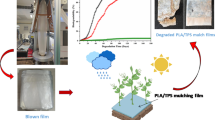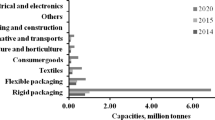Abstract
Biopolymeric films were obtained using starch extracted from jackfruit seeds with the addition of cellulose from sisal fiber (reinforcing agent) and glycerol (plasticizing agent). The objective was to obtain materials with noble properties for application in the field of biodegradable packaging, thus highlighting its importance at a sustainable level. The biopolymeric films were formulated using the casting method, mixing cellulose extracted from sisal fiber with proportions (m/m) varying between 2 and 10%. The biopolymeric films were evaluated for thickness, water solubility, water solubility and water vapor permeability (PVA). Also, they characterized by mechanical tests, FTIR–ATR and TG/DTG. The results showed that the biopolymeric films were 0.5% more soluble in acidic media than in water with increasing cellulose concentration. The water vapor permeability of the samples was inversely proportional to the percentage of cellulose incorporation. Tensile tests showed that the maximum stress and strain at break increased with increasing cellulose concentration. The incorporation of cellulose in the biopolymeric films was confirmed by FTIR, it was possible to observe a decrease in the intensity of the absorption band in the region between 3500 and 3100 cm−1 in relation to the film without cellulose. Furthermore, by TG/DTG, an increase in the thermal stability of biopolymeric films with cellulose was observed. It is suggested that such biopolymeric films are promising and have potential application in the preparation of films for packaging. In addition to replacing petroleum-based polymeric films, they have the advantage of being biodegradable.






Similar content being viewed by others
References
Langmaier F, Mládek M, Mokrejš P, Kolomazník K. Biodegradable packing materials based on waste collagen hydrolysate cured with dialdehyde starch. J Therm Anal Calorim. 2008. https://doi.org/10.1007/s10973-007-8293-3.
Geyer R, Jambeck JR, Law KL. Production, use, and fate of all plastics ever made. Sci Adv. 2017. https://doi.org/10.1126/sciadv.1700782.
Zhu X, He Q, Hu Y, Huang R, Shao N, Gao Y. A comparative study of structure, thermal degradation, and combustion behavior of starch from different plant sources. J Therm Anal Calorim. 2018. https://doi.org/10.1007/s10973-018-7030-4.
Copeland L, Blazek J, Salman H, Tang MC. Form and functionality of starch. Food Hydrocoll. 2009. https://doi.org/10.1016/j.foodhyd.2008.09.016.
Worzakowska M. Thermo-oxidative decomposition behavior of starch-g-poly(citronellyl methacrylate) and starch-g-poly(citronellyl acrylate) copolymers. J Therm Anal Calorim. 2018. https://doi.org/10.1007/s10973-017-6950-8.
Damodaran S, Parkin KL. Fennema’s food chemistry. 5th ed. Porto Alegre; 2019.
Punia S. Barley starch modifications: physical, chemical and enzymatic—a review. Int J Biol Macromol. 2020. https://doi.org/10.1016/j.ijbiomac.2019.12.088.
Ashogbon AO. Dual modification of various starches: synthesis, properties and applications. Food Chem. 2021. https://doi.org/10.1016/j.foodchem.2020.128325.
Nawaz H, Waheed R, Nawaz M, Shahwar D. Physical and chemical modifications in starch structure physical and chemical modifications in starch structure and reactivity. Chem Prop Starch Intech Open. 2020. https://doi.org/10.5772/intechopen.88870.
Baliga MS, Shivashankara AR, Haniadka R, Dsouza J, Bhat HP. Phytochemistry, nutritional and pharmacological properties of Artocarpus heterophyllus Lam (jackfruit): a review. Food Res Int. 2011. https://doi.org/10.1016/j.foodres.2011.02.035.
Schwach E, Avérous L. Starch-based biodegradable blends: Morphology and interface properties. Polym Int. 2004. https://doi.org/10.1002/pi.1636.
Frone AN, Panaitescu DM, Chiulan I, Gabor AR, Nicolae CA, Oprea M, Puitel AC. Thermal and mechanical behavior of biodegradable polyester films containing cellulose nanofibers. J Therm Anal Calorim. 2019. https://doi.org/10.1007/s10973-019-08218-4.
Sueiro AC, Faria-Tischerb PCS, Lonnic AASG, Mali S. Filmes biodegradáveis de amido de mandioca, pululana e celulose bacteriana. Quim Nova. 2016. https://doi.org/10.5935/0100-4042.20160118.
Rocha GO, Farias MG, de Carvalho CWP, Ascheri JLR, Galdeano MC. Biodegradable composite films based on cassava starch and soy rotein. Polymer. 2014. https://doi.org/10.1590/0104-1428.1355.
Mali S, Grossmann MVE, Garcia MA, Martino MN, Zaritzky NE. Microstructural characterization of yam starch films. Carbohydr Polym. 2002. https://doi.org/10.1016/S0144-8617(02)00058-9.
Mali S, Grossmann MVE, Yamashita F. Filmes de amido: produção, propriedades e potencial de utilização. Cienc Agrar. 2010. https://doi.org/10.5433/1679-0359.2010v31n1p137.
Mali S, Grossmann MVE, García MA, Martino MM, Zaritzky NE. Barrier, mechanical and optical properties of plasticized yam starch films. Carbohydr Polym. 2004. https://doi.org/10.1016/j.carbpol.2004.01.004.
Khan A, Khan RA, Salmieri S, Tiena CL, Riedl B, Bouchard J, Chauve G, Tand V, Kamal MR, Lacroix M. Mechanical and barrier properties of nanocrystalline cellulose reinforced chitosan-based nanocomposite films. Carbohydr Polym. 2012. https://doi.org/10.1016/j.carbpol.2012.07.037.
Laohakunjit N, Noomhorm A. Effect of plasticizers on mechanical and arrier properties of rice starch film. Starch/Stärke. 2004. https://doi.org/10.1002/star.200300249.
Rinaldi R, Schuth F. Acid hydrolysis of cellulose as the entry point into biorefinery schemes. Chem Sus Chem. 2009. https://doi.org/10.1002/cssc.200900188.
García NL, Ribba L, Dufresne A, Aranguren MI, Goyanes S. Physico-mechanical properties of biodegradable starch nanocomposites. Macromol Mater Eng. 2009. https://doi.org/10.1002/mame.200800271.
Yu L, Dean K, Li L. Polymer blends and composites from renewable resources. Prog Polym Sci. 2006. https://doi.org/10.1016/j.progpolymsci.2006.03.002.
Bourtoom T, Chinnan MS. Preparation and properties of rice starch-chitosan blend biodegradable film. J Food Sci Technol. 2008. https://doi.org/10.1016/j.lwt.2007.10.014.
Gutiérrez TJ, Morales NJ, Pérez E, Tapia MS, Famá L. Physico-chemical properties of edible films derived from native and phosphated cush-cush yam and cassava starches. Food Packag Shelf Life. 2015. https://doi.org/10.1016/j.fpsl.2014.09.002.
Müller C, Yamashita F, Laurindo JB. Evaluation of effects of glycerol and sorbitol concentration and water activity on the water barrier properties of cassava starch films through a solubility approach. Carbohydr Polym. 2008. https://doi.org/10.1016/j.carbpol.2007.07.026.
Li X, Tabil LG, Panigrahi S. Chemical treatments of natural fiber for use in natural fiber-reinforced composites: a review. J Polym Environ. 2007. https://doi.org/10.1007/s10924-006-0042-3.
Callister WD. Materials science and engineering: an introduction. 7th ed. Wiley; 2008.
Shackelford JF. Materials science. 6th ed. Pearson; 2008.
Marques PT, Lima AMF, Bianco G, Laurindo JB, Borsali R, Le Meins JF, Soldi V. Thermal properties and stability of cassava starch films cross-linked with tetraethylene glycol diacrylate. Polym Degrad Stab. 2006. https://doi.org/10.1016/j.polymdegradstab.2005.05.020.
Schlemmer D, Sales MJA, Resck IS. Preparação, caracterização e degradação de blendas PS/tps usando glicerol e óleo de buriti como plastificantes. Polím Ciênc Tecnol. 2010. https://doi.org/10.1590/S0104-14282010005000002.
Acknowledgements
The authors thank the funding agency CAPES for granting the scholarship and the post-graduation program PGQA (UNEB) and IFBaiano-Catu, LAPESCA-UFBA and LATIG-IQ-USP for the infrastructures provided.
Author information
Authors and Affiliations
Corresponding author
Additional information
Publisher's Note
Springer Nature remains neutral with regard to jurisdictional claims in published maps and institutional affiliations.
Rights and permissions
Springer Nature or its licensor (e.g. a society or other partner) holds exclusive rights to this article under a publishing agreement with the author(s) or other rightsholder(s); author self-archiving of the accepted manuscript version of this article is solely governed by the terms of such publishing agreement and applicable law.
About this article
Cite this article
S. Castro, F., R. Matos, J., Mercuri, L.P. et al. Synthesis and evaluation of the incorporation of sisal fiber cellulose in the polymeric matrix of starch from jackfruit seed (Artocarpus heterophyllus Lam.) using thermogravimetry. J Therm Anal Calorim 148, 97–105 (2023). https://doi.org/10.1007/s10973-022-11768-9
Received:
Accepted:
Published:
Issue Date:
DOI: https://doi.org/10.1007/s10973-022-11768-9




